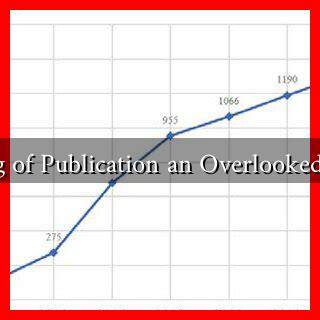-
Table of Contents
Is Timing of Publication an Overlooked Element?
In the fast-paced world of information dissemination, the timing of publication often takes a backseat to content quality and relevance. However, the timing of when an article, study, or news piece is released can significantly impact its reach, engagement, and overall success. This article explores the importance of timing in publication, supported by examples, case studies, and statistics.
The Importance of Timing in Publication
Timing can be a critical factor in determining how well a piece of content performs. Here are some reasons why timing matters:
- Audience Engagement: Releasing content when your target audience is most active can lead to higher engagement rates.
- Relevance: Timely publications can capitalize on current events or trends, making them more relevant and shareable.
- SEO Benefits: Search engines often favor fresh content, which can improve visibility and ranking.
Case Studies: Timing in Action
Several case studies illustrate how timing can make or break a publication’s success.
1. The Viral Nature of News Articles
In 2016, a study by the Pew Research Center found that news articles published within hours of a major event received significantly more shares and engagement than those published later. For instance, during the 2016 U.S. presidential election, articles covering breaking news events garnered up to 50% more social media shares than those that were published days later.
2. Academic Publishing
In the realm of academic publishing, timing can also play a crucial role. A study published in the journal Scientometrics found that articles published in January and February received more citations than those published later in the year. This phenomenon is attributed to the academic calendar, where many researchers are more active in the early months of the year.
Statistics That Speak Volumes
Several statistics highlight the importance of timing in publication:
- According to a study by HubSpot, content published on weekdays, particularly Tuesdays and Thursdays, receives 20% more engagement than content published on weekends.
- A report from CoSchedule indicates that articles published between 9 AM and 11 AM receive the highest traffic, as this is when most people check their emails and social media.
- Research by BuzzSumo shows that articles that are timely and relevant to current events are shared 30% more often than those that are not.
Strategies for Optimal Timing
To leverage the timing of publication effectively, consider the following strategies:
- Monitor Trends: Use tools like Google Trends or social media analytics to identify trending topics and optimal times for publication.
- Understand Your Audience: Analyze your audience’s behavior to determine when they are most active online.
- Plan Ahead: Create a content calendar that aligns with key dates, events, or seasons relevant to your audience.
Conclusion: The Overlooked Element
In conclusion, the timing of publication is an often-overlooked element that can significantly influence the success of content. By understanding the importance of timing and implementing effective strategies, publishers can enhance engagement, relevance, and visibility. As the digital landscape continues to evolve, recognizing the power of timing will be essential for anyone looking to make an impact in their field.
Ultimately, whether you are a journalist, academic, or content creator, paying attention to when you publish can be just as important as what you publish. By aligning your content with the right moments, you can maximize its potential and reach your audience more effectively.

